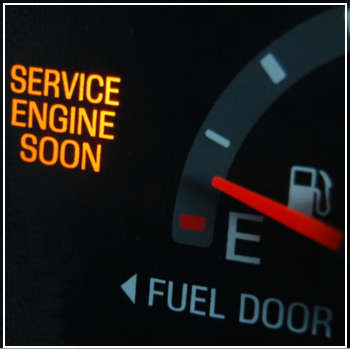 As you’re driving along the highway, your car seems perfectly fine. Then, the check engine light appears on your dashboard, catching you by complete surprise. Your car hasn’t been making any noises or driving sluggishly, so what could be wrong? For many drivers who take good care of their vehicles, this sign can be both irritating and puzzling.
As you’re driving along the highway, your car seems perfectly fine. Then, the check engine light appears on your dashboard, catching you by complete surprise. Your car hasn’t been making any noises or driving sluggishly, so what could be wrong? For many drivers who take good care of their vehicles, this sign can be both irritating and puzzling.
Although the check engine light usually indicates that your car needs maintenance, it’s generally safe to keep driving for a few days before you can schedule an appointment for service. In fact, lights for your oil or tire pressure indicate a need for immediate maintenance. When your check engine light comes on, consider these potential causes:
1. A Gas Cap Could Be Loose
Within the realm of car diagnostics, the check engine light could mean something as simple as a loose gas cap. When the cap is not screwed on tight, your tank’s fuel evaporates quicker and can trigger the sensor for the check engine light.
When this happens, it’s a good idea to just pull over and check the gas cap first to make sure it’s secured tightly and not cracked. After you do so, the light should turn off within 20 minutes of driving.
2. Repairs May Be Needed
What happens after you’ve tightened your gas cap and the light stays on? In that case, your check engine light may be telling you that your car has a damaged vacuum hose or ignition coil, a catalytic converter that doesn’t work or old and worn out spark plugs. One of the following parts may need to be replaced:
- Oxygen Sensor: This part monitors your exhaust system’s unburned oxygen. When it doesn’t get replaced, your car will start losing fuel and your catalytic converter may be further damaged.
- Catalytic Converter: This part reduces your car’s exhaust gases and when it’s not performing up to par, your fuel economy starts to decrease. If it continues to go unchecked, your car may not accelerate when you press on the gas, won’t be able to pass an emissions test or may not even run.
- Mass Airflow Sensor: This component signals the proper fuel level to your car. Without maintenance, it may decrease your vehicle’s fuel economy, damage your spark plug, oxygen sensor or catalytic converter and even stall your car.
- Spark Plugs and Plug Wires: When these components need to be replaced, your car may have impacted performance, including less power and reduced fuel economy. As they continue to go unchecked, your catalytic converter may become clogged and your ignition coils and oxygen sensors may experience damage. As a result of these factors, repairs should be done as soon as possible.
- Cracked Gas Cap: Even if you can tighten your gas cap, it still may be cracked. In this scenario, your cap’s allowing fuel vapors to escape, which throws off your fuel system and decreases gas mileage. In terms of repairs, this may be the easiest; short term, you can buy a replacement cap at the auto parts store.
3. Make a Diagnostic Appointment
To narrow down these possibilities, it’s recommended that you schedule an appointment with a mechanic, who will then run a diagnostic test. A small computer is plugged in under the dashboard, which then generates a code indicating what is wrong with your car. Using this information, the mechanic can perform the necessary maintenance on your vehicle.
Did your car’s check engine light come on recently? Instead of tinkering with it yourself, make a diagnostic appointment with DaSilva’s Auto Body. To learn more, contact our Naugatuck location today.




